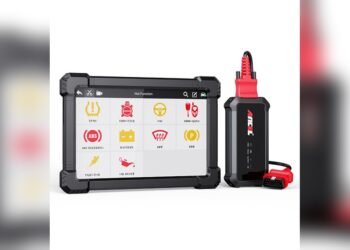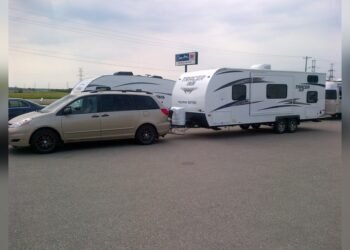Car overheating when the AC is on and the car is idle is a common issue. It can be frustrating and concerning for any driver.
Imagine sitting in traffic on a hot day, and suddenly, your car’s temperature gauge starts to rise. This problem can be alarming, but it’s important to understand what might be causing it. Overheating can lead to serious engine damage if not addressed promptly.
By identifying the root causes, you can take steps to prevent this issue from happening again. This blog post will explore the reasons why your car might overheat in these conditions and offer some practical solutions. Stay tuned to learn more about keeping your vehicle cool and running smoothly.

Credit: www.youtube.com
Common Causes
Experiencing a car that overheats when the AC is on and idle can be frustrating. This common issue can stem from several factors. Understanding these causes can help address the problem and keep your car running smoothly. Let’s dive into the common causes of this issue.
Low Coolant Levels
Low coolant levels can cause your engine to overheat. Coolant helps regulate the engine’s temperature. Without enough coolant, the engine struggles to stay cool. Check the coolant level regularly and top it up if needed.
Faulty Radiator Fan
The radiator fan cools the engine by moving air through the radiator. A faulty fan can’t perform this task. When the car is idle, the engine can overheat. Inspect the fan for damage or wear. Replace it if it is not working.
Clogged Radiator
A clogged radiator can restrict the flow of coolant. Debris and dirt can build up inside. This blockage prevents the radiator from cooling the engine efficiently. Cleaning the radiator can improve its performance. Ensure the radiator is free from obstructions for optimal cooling.
Checking Coolant Levels
When your car overheats with the AC on and idle, checking coolant levels is essential. Coolant helps regulate engine temperature. If levels are low, the engine can overheat.
How To Inspect
First, ensure the car is cool. Open the hood carefully. Locate the coolant reservoir. It’s usually a clear plastic tank. The side of the tank has markings. These indicate the optimal coolant level.
Look for the “Full” line. The coolant should be at this level. If it’s below, more coolant is needed. Also, check the color. It should be green, yellow, or pink. Discolored coolant may indicate a problem.
Top-up Procedures
Get the correct type of coolant. Refer to your car’s manual. Remove the coolant reservoir cap. Slowly pour the coolant into the tank. Fill until it reaches the “Full” line. Do not overfill.
After topping up, replace the cap securely. Start the engine. Let it run for a few minutes. Check the coolant level again. It may settle and need a bit more. If the coolant level drops quickly again, consult a mechanic.
Radiator Fan Issues
When your car overheats with the AC on and idling, one common cause is radiator fan issues. The radiator fan helps cool the engine by pulling air through the radiator. If the fan is faulty, your engine can overheat, especially when the car is not moving.
Identifying Faulty Fans
First, you need to identify a faulty radiator fan. Here are some steps to check if your radiator fan is working correctly:
- Turn on your car and let it idle.
- Turn on the AC and wait for a few minutes.
- Open the hood and listen for the fan noise.
- If you do not hear the fan, it might be faulty.
Another method is to check for a warning light on your dashboard. If the engine temperature warning light comes on, it could be due to a faulty fan. You can also use a digital multimeter to test the fan motor. Set the multimeter to the resistance (ohms) setting. Then, connect the probes to the fan motor terminals. If the reading is too high or infinite, the fan motor is defective.
Replacing The Fan
Once you have identified the faulty fan, you need to replace it. Follow these steps to replace the radiator fan:
- Disconnect the battery to avoid electrical shocks.
- Locate the fan assembly near the radiator.
- Unplug the electrical connectors from the fan.
- Remove the bolts holding the fan assembly in place.
- Take out the old fan and replace it with the new one.
- Reattach the bolts and plug in the electrical connectors.
- Reconnect the battery and start your car.
Test the new fan by turning on the AC and letting the car idle. Make sure the fan runs smoothly and keeps the engine cool. Regular maintenance of the radiator fan is crucial to prevent overheating issues.
Radiator Blockages
Experiencing your car overheating when the AC is on and idle can be frustrating. One common cause is radiator blockages. The radiator helps in cooling the engine. Any blockage can disrupt this process.
Signs Of Clogging
Identifying the signs of a clogged radiator is crucial. Here are some common indicators:
- Engine Overheating: The temperature gauge rises quickly when the AC is on.
- Coolant Leaks: You might notice puddles of coolant under your car.
- Discolored Coolant: The coolant appears rusty or has debris.
- Reduced Coolant Flow: Lower levels of coolant in the reservoir.
Cleaning Techniques
Cleaning the radiator can prevent overheating. Here are some effective methods:
- Flush the Radiator: Use a radiator flush solution. Follow the instructions on the product.
- Use Compressed Air: Blow air through the radiator fins. This removes dust and debris.
- Check the Hoses: Ensure all hoses are clear and free from blockages.
- Inspect the Radiator Cap: Replace if it’s damaged or not sealing properly.
Regular maintenance can keep your radiator working efficiently. Don’t ignore the signs of clogging. Ensure your engine stays cool, even when the AC is on.
Thermostat Problems
Thermostat problems can cause your car to overheat when the AC is on and the vehicle is idle. The thermostat regulates the flow of coolant to the engine. If it fails, the engine may not receive enough coolant. This can lead to overheating, especially when the AC adds extra load.
Diagnosing A Bad Thermostat
To diagnose a bad thermostat, start by checking the engine temperature gauge. If the needle rises quickly after starting, the thermostat may be stuck closed. Another sign is if the heater blows cold air, indicating coolant is not circulating properly.
Use a thermometer to measure the radiator temperature. If it stays cool while the engine overheats, the thermostat might be faulty. Also, look for coolant leaks around the thermostat housing, which can indicate a bad seal.
Steps To Replace
To replace the thermostat, follow these steps:
- Cool the engine: Ensure the engine is completely cool to avoid burns.
- Drain the coolant: Place a container under the radiator and open the drain valve.
- Remove the thermostat housing: Locate the housing, usually near the top of the engine, and remove the bolts.
- Take out the old thermostat: Note the orientation of the old thermostat and carefully remove it.
- Install the new thermostat: Place the new thermostat in the same orientation as the old one.
- Reassemble the housing: Reattach the housing and tighten the bolts securely.
- Refill the coolant: Refill the radiator with coolant and check for leaks.
- Run the engine: Start the engine and let it reach operating temperature. Check the temperature gauge and heater function.
Replacing a thermostat is a straightforward process. This can prevent your car from overheating when the AC is on and idle.

Credit: www.reddit.com
Water Pump Failures
Experiencing a car that overheats when the AC is on and idle can be frustrating. One common culprit behind this issue is water pump failures. The water pump plays a critical role in your vehicle’s cooling system. It helps circulate coolant throughout the engine to maintain a stable temperature. When it fails, the coolant flow is disrupted, leading to overheating. Let’s dive deeper into this problem with the following sections.
Symptoms To Watch For
Knowing the signs of a failing water pump can save you from bigger headaches. Here are some symptoms to watch for:
- Coolant Leaks: Look for puddles under your car. These leaks often come from the water pump.
- Overheating Engine: If your engine overheats, especially when idle, the water pump could be failing.
- Whining Noise: A high-pitched noise from the engine area could indicate a worn-out water pump bearing.
- Steam from Radiator: Steam or smoke from the radiator area means the coolant isn’t circulating properly.
Replacement Guide
If you identify any of the symptoms, it might be time to replace the water pump. Here’s a simple guide to help you:
- Prepare Your Tools: You’ll need a wrench, screwdrivers, and a new water pump.
- Drain the Coolant: Place a container under the radiator and open the drain valve.
- Remove the Old Pump: Detach the old water pump by removing the mounting bolts.
- Clean the Mounting Surface: Ensure the area is clean and free of old gasket material.
- Install the New Pump: Place the new water pump in position and secure it with bolts.
- Refill the Coolant: Refill the radiator with fresh coolant and check for leaks.
- Test the Engine: Start the engine and let it idle. Monitor the temperature gauge.
This guide offers a basic overview. Always refer to your car’s manual for specific instructions.
Ac System Impact
Experiencing your car overheating with the AC on while idle is frustrating. This issue often ties back to the AC system’s impact on the engine. Understanding this can help you manage the problem better.
How Ac Affects Engine Temperature
The air conditioning system puts additional strain on the engine. When the AC is on, the engine works harder to keep the car cool. This extra effort can lead to increased engine temperature, especially if the car is idle.
When idle, the car’s cooling system relies on the radiator fan. If the fan isn’t efficient, the engine may overheat. The AC system demands more power, leading to higher engine temperature.
Managing Load
Managing the load on your engine can prevent overheating. Here are some tips:
- Ensure the radiator fan is working properly.
- Check coolant levels regularly.
- Keep the AC system well-maintained.
- Turn off the AC if the engine starts to overheat.
By taking these steps, you can reduce the strain on your engine and avoid overheating.

Credit: www.reddit.com
Preventive Measures
Experiencing a car that overheats when the AC is on and idle can be frustrating. Prevention is key to avoid this issue. By taking some preventive measures, you can ensure your vehicle runs smoothly, even on hot days.
Regular Maintenance Tips
Regular maintenance keeps your car in good shape. Here are some tips:
- Check coolant levels frequently.
- Inspect the radiator for any leaks.
- Ensure the fan belt is not worn out.
- Clean debris from the radiator fins.
Perform these checks monthly. They prevent overheating and extend your car’s life.
Upgrading Cooling Systems
Sometimes, regular maintenance is not enough. Upgrading your cooling system can make a big difference:
| Upgrade | Benefit |
|---|---|
| High-Performance Radiator | Better heat dissipation |
| Electric Fan | Improved airflow |
| Thermostatic Fan Control | Optimized fan usage |
These upgrades ensure your car stays cool, even with the AC on.
Frequently Asked Questions
Why Does My Car Overheat When The Ac Is On And Idle?
Your car might overheat due to a failing radiator fan. The fan helps cool the engine, especially when idle.
How Can I Fix My Car Overheating At Idle?
Check the radiator fan and coolant levels. Replace any faulty parts. Consult a mechanic if needed.
Is It Safe To Drive If My Car Overheats With Ac On?
No, it isn’t safe. Overheating can cause engine damage. Stop driving and let the engine cool down first.
Can A Bad Thermostat Cause Overheating With Ac On?
Yes, a faulty thermostat can restrict coolant flow. This can lead to overheating, especially when the AC is on.
What Are Other Signs Of A Failing Radiator Fan?
Other signs include loud noises from the engine, AC not cooling properly, and frequent engine overheating.
Conclusion
Regular car maintenance can prevent overheating with the AC on while idle. Check coolant levels frequently. Ensure your radiator fan functions properly. Replace old or worn-out belts. Regularly inspect your car’s cooling system. Simple steps can save you from bigger issues.
Your car deserves proper care. Keep it cool, even during idle times. Stay proactive to enjoy a smoother drive.
















